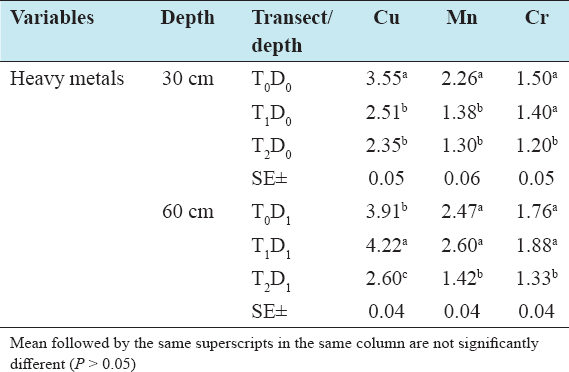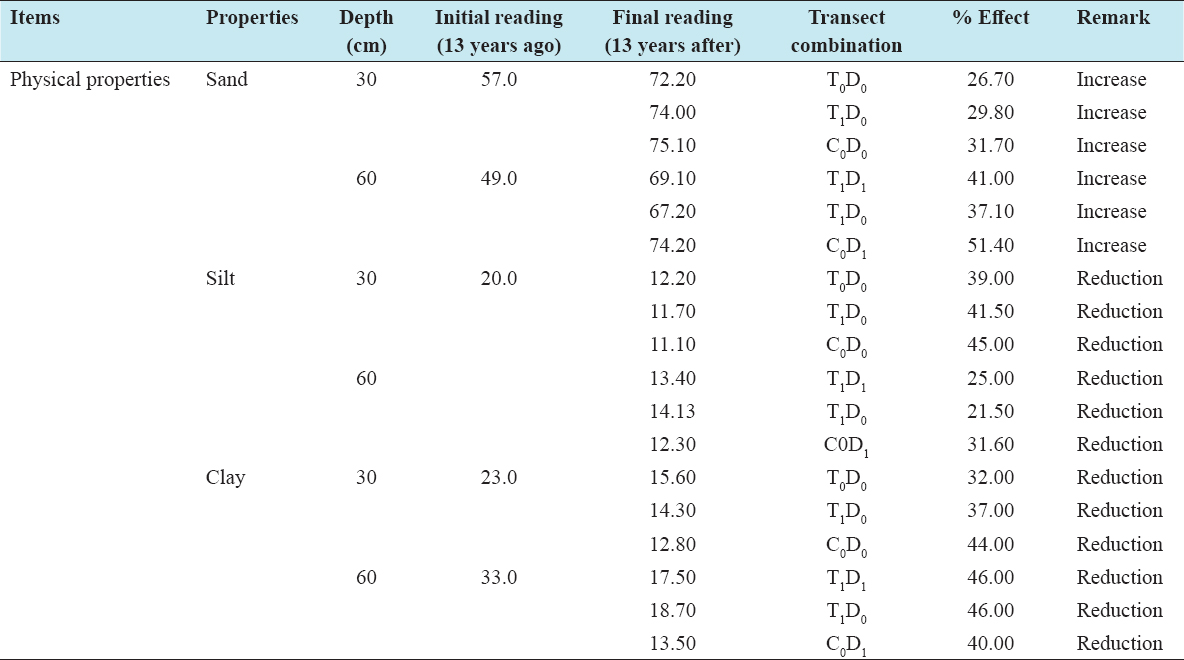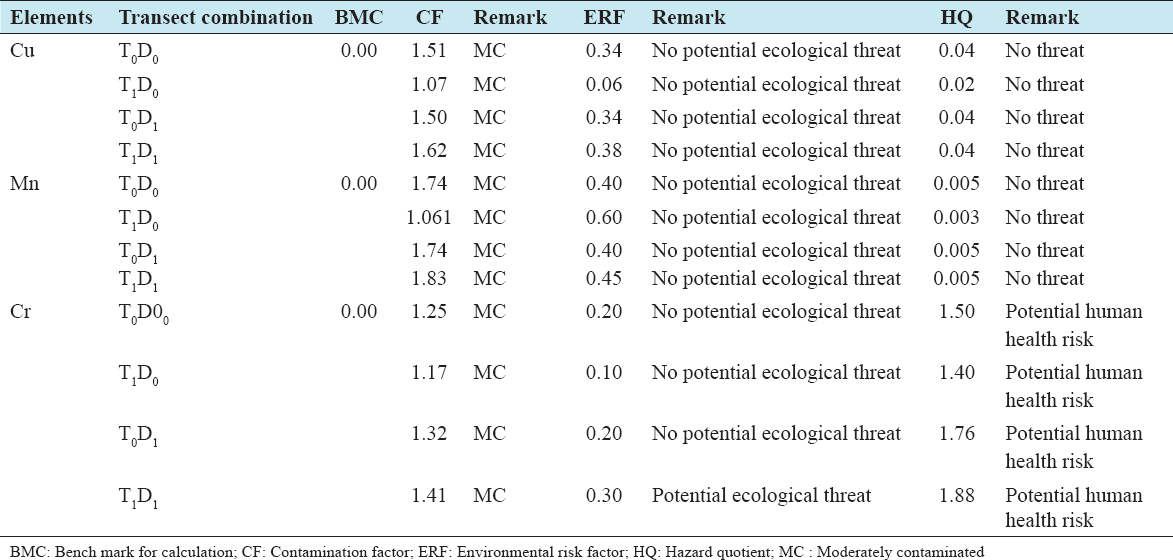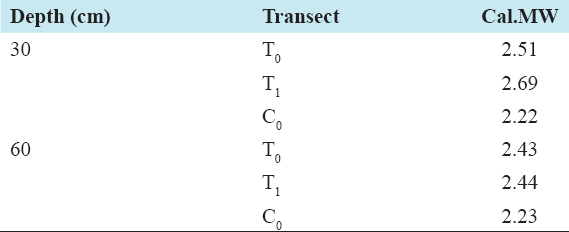1. Egeru A, Majaliwa JG. Land use/cover change trend in Soroti district in Eastern Uganda. J Appl Sci Environ Manage 2009;13:77-9.
2. Leita L, de Nobili LL, Mondicini M, Muhlbachona G, Contin M. Influence of organic fertilization and soil microbial biomass, metabolic quotient and heavy metal bioavailability. Biol Fertil Soils 1999;28:371-6.
3. Kuzyakov Y, Biryukova OV, Kuznetzova TV, Mölter K, Kandeler E, Stahr K. Carbon partitioning in plant and soil, carbon dioxide fluxes and enzyme activities as affected by cutting ryegrass. Biol Fertil Soils 2002;35:348-58.
4. Huygens D, Boeckx P, Van Cleemput O, Oyarzun CE, Godoy R. Aggregate and soil organic carbon dynamics in south Chilean andisols. Biogeosciences 2005;2:159-74.
5. Chen CR, Xu ZH. Soil carbon and nitrogen pools and microbial properties in a 6-year-old slash pine plantation of subtropical Australia:Impacts of harvest residue management. For Ecol Manage 2005;206:237-47.
6. Trasar-Cepeda C, Leirós MC, Seoane S, Gil-Sotres F. Biochemical properties of soils under crop rotation. Appl Soil Ecol 2008;39:133-43.
7. OECD. Environmental Performance of Agriculture in OECD Countries Since 1990. Paris, France:OECD;2008. 10.
8. Huffman T, Coote D. Soil cover in Canada. In:Eilers W, Mackay R, Graham L, Lefebvre A, editors. Environmental Sustainability of Canadian Agriculture. Ottawa:Agriculture and Agric-Food Canada;2010. 31-5.
9. Labiru MA, Binbol NL. Analysis of Solar Radiation and Sunshine Hours at the University of Jos Meteorological Station, Bauchi Road Campus Jos-Plateau State. In:International Conference proceedings of Nigeria Meteorological Society Held in Sokoto State, Nigeria 23rd-26th Nov;2015. p. 91-2.
10. Kareem IA. Soil chemical properties as influenced by Albizia lebbeck Benth (Rattle Tree) under agri-silvicultural system (alley cropping) with Solanum tuberosum Linn. (Potato). DonnishJ Hortic Forest 2015;1:1-11.
11. Blake GR, Hartge KH. Bulk density. In:Klute A, editor. Methods of Soil Analysis, Physical and Mineralogical Methods. Madison, WI, USA:ASA;1986. 363-75.
12. Van Reewijk LP. Procedures for Soil Analysis. 3rd ed. Wageningen, Netherlands:International Soil Reference Center (ISRIC);1992.
13. Brandy NC, Weil RR. Elements of the Nature and Properties of Soils. 3rd ed. Boston:Prentice Hall;2010.
14. Rhoades JD. Salinity:Electrical conductivity and total dissolved solids. In:Sparks DL, editor. Methods of Soil Analysis:Chemical Methods. Part 3. Madison, WI:Soil Science Society of America;1996.
15. Burt S. Essential oils:Their antibacterial properties and potential applications in foods-a review. Int J Food Microbiol 2004;94:223-53.
16. Ball DF. Loss on ignition as an estimate of organic matter and organic carbon in non-calcareous soils. J Soil Sci 1964;15:84-92.
17. Jackson ML. Soil Chemical Analysis. New Delhi:Prentice Hall of India Pvt. Ltd.;1973. 38-56.
18. Habtamu FG, Negussie R, Gulelat DH, Ashagrie ZW. Nutritional quality and health benefits of okra (Abelmoschus Esculentus):A review. Global J Med Res 2014;14:28-37.
19. da Silva EB, Li S, de Oliveira LM, Gress J, Dong X, Wilkie AC, et al. Metal leachability from coal combustion residuals under different pHs and liquid/solid ratios. J Hazard Mater 2018b;341:66e74.
20. Chapman HD. Cation-exchange Capacity. In:Black CA, editor. Method of Soil Analysis, Part 2:Chemical and Microbiological Properties. Madison, Wisconsin:American Society of Agronomy;1965. 891-900.
21. Asadu CL, Dixon AG, Ajogu GM, Ugadu M, Edeh I. Comparison of the suitability of contiguous fallow-forest lands for cassava, yam, cocoyam and sweet potato production in Nsukka, Southeastern Nigeria. Path Sci Int Electron Sci J 2017;3:1-12.
22. Alef K, Nannipieri P. Enzyme activities. In:Alef K, Nannipieri P, editor. Methods in Applied Soil Microbiology and Biochemistry. London:Academic Press;1995.
23. American Society of Anesthesiologists. American Society of Agronomy Plant and Soil Environ. United States:American Society of Anesthesiologists;2007.
24. Kalembasa S, Symanowicz B. Enzymatic activity of soil after applying various waste organic materials, ash, and mineral fertilizers. Pol J Environ Stud 2012;21:1635-41.
25. Sabba RN. Soil Microbiology:Soil Micro-organism and Plant Growth. New Delhi:Oxford Publisher;1995. 509.
26. Efroymson RA, Will ME, Suter GW II, Wooten AC. Toxicological Benchmarks for Screening Contaminants of Potential Concern for Effects on Terrestrial Plants:1997 Revision. United States:ES/ER/TM-85/R3.U.S. Department of Energy, Office of Environmental Management;1997. 123.
27. Renella G, Ortigoza AL, Landi L, Nannipieri P. Additive effects of copper and zinc on cadmium toxicity on phosphatase activities and ATP content of soil as estimated by the ecological dose (ED 50). Soil Biol Biochem 2003;35:1203-10.
28. Geiger G, Brandi H, Furner G, Schulin R. The effect of copper on the activity of cellulose and b-glucosidase in the presence of montmorillonite or Al-montmorillonite. Soil Biol Biochem 1998;30:1537-44.
29. Bi Y, Zhang Y. Role of the different planting age of seabuckthorn forests to soil amelioration in coal mining subsidence land. Int J Coal Sci Technolol 2014;1:192-7.
30. Gonnety JT, Assémien EF, Guéi AM, N'Dri AA, Djina Y, KonéAW, et al. Effect of land-use types on soil enzymatic activities and chemical properties in semi-deciduous forest areas of Central-West Cote d'Ivoire. Biotechnol Agron Soc Environ 2012;16:478-85.
31. Brallier S, Harrison RB, Henry CL, Dongsen X. Liming effects on availability of Cd, Cu, Ni and Zn in a soil amended with sewage sludge 16 years previously. Water Air Soil Pollut 1996;86:195-206.
32. Ibrahim AK. Rattle tree (Albizia lebbeck) effects on soil properties and productivity of Irish potato (Solanum tuberrosum) on the Jos Plateau, Nigeria. Ratar Povrt 2003;2:141.
33. Naidu R, Bolan N. Contaminant chemistry in soils:Key concepts and bioavailability. Chem Bioavailabil Terrestrial Environ 2008;9:38.
34. Alamgir M, Islam M, Hossain N, Kibria MG, Rahman MM. Assessment of heavy metal contamination in urban soils of Chittagong city, Bangladesh. Int J Plant Soil Sci 2015;7:362-72.
35. Chen M, Ma LQ, Harris WG. Baseline concentrations of 15 trace elements in Florida surface soils. J Environ Qual 1999;28:1173-81.
36. Chandrakar V, Verma P, Jamaluddin. Removal of Cu and Zn by fungi in municipal sewage water. IJABR 2012;2:1-4.
37. Mishra UK, Sahu SK, Mitra GN, Das R. Effect of sulphur and lime on yield and oil content of Kharif groundnut grown in Haplaquept. J Indian Soc Soil Sci 1990;38:772-4.
38. Holtan-Hartwig L, Bechmann M, Hoyas TR, Linjordet R, Bakken LR. Heavy metals tolerance of soil denitrifying communities:N2O dynamics. Soil Biol Biochem 2002;34:1181-90.
39. Majer BJ, Tscherko D, Paschke A, Wennrich R, Kundi M, Kandeler E, et al. Effects of heavy metal contamination of soils on micronucleus induction in Tradescantia and on microbial enzyme activities:A comparative investigation. Gen Toxicol Environ Mutage 2002;515:111-24.
40. Galli U, Schuepp H, Brunold C. Heavy metal binding by mycorrhizal fungi. Physiol Plant 1994;92:364-8.
41. Lasat MM, Baker AJ, Kochian LV. Altered Zn compartmentation in the root symplasm and stimulated Zn absorption into the leaf as mechanisms involved in Zn hyperaccumulation in Thalspi caerulescens. Plant Physiol 1998;118:875-83.
42. Wyszkowska J, Kurcharski J, Lajszner W. The effects of copper on soil biochemical properties and its interaction with other heavy metals. Polish J Environ Stud 2006;15:927-34.
43. Burns RG. Soil Enzymes. London, UK:Academic Press;1978.
44. Yang Z, Liu S, Zheng D, Feng S. Effects of cadmium, zinc, and lead on soil enzyme activities. J Environ Sci 2006;18:1135-41.
45. Pruvot C, Douay F, Herve F, Waterlot C. Heavy metals in soils, crops and grass as a source of human exposure in the former mining areas. J Soil Sediment 2006;6:215-20.
46. Zhuang P, Zou B, Li NY, Li ZA. Heavy metal contamination in soils and food crops around Dabaoshan mine in Guangdong, China:Implications for human health. Environ Geochem Health 2009;31:707-15.
47. Huang Q, Shindo H. Effects of copper on the activity and kinetics of free and immobilized acid phosphatase. Soil Biol Biochem 2000;32:1885-92.
48. Khan S, Cao Q, Hesham AE, Xia Y, He J. Soil enzymatic activities and microbial community structure with different application rates of Cd and Pb. J Environ Sci 2007;19:834-40.
49. Hu C, Cao Z. Size and activity of the soil microbial biomass and soil enzyme activity in long-term field experiments. World J Agric Sci 2007;3:63-70.
50. Liu YM, Yang HY, Li XR, Xing ZS. Effects of biological soil crusts on soil enzyme activities in revegetated areas of the Tengger Desert, China. Appl Soil Ecol 2014;80:6-14.













